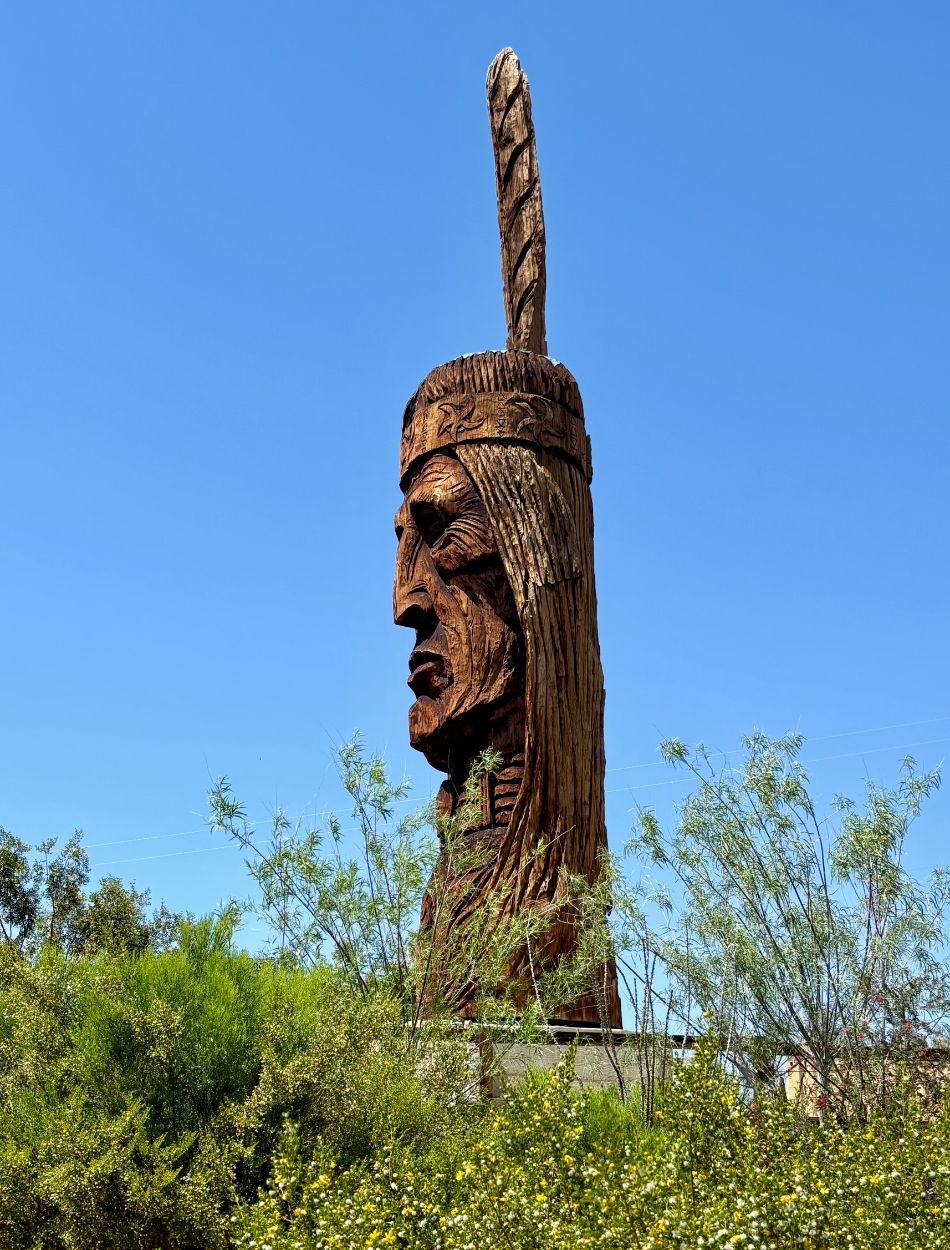OTHER THAN THE OVERALL glam reputation of Palm Springs, I had no idea about the city’s history, except what I’ve gleaned from Hollywood tales of movie-star shenanigans.
Unsurprisingly, given they have been around for millennia, the Agua Caliente Band of Cahuilla Indians owns the whole of downtown Palm Springs. One square mile of the heart of the city – known as Section 14 – is part of the Agua Caliente Reservation, established in 1876. As a result, all the downtown businesses lease their spaces from the 450-member tribe, which owns about 13,000 hectares of land in the region in total.

The Agua Caliente Cultural Museum opened in November 2023 after years of planning. Photo courtesy of the Agua Caliente Band of Cahuilla Indians

The Agua Caliente Women sculpture, created by Doug Hyde in 1994, depicts two Agua Caliente Band of Cahuilla Indian women, symbolizing their traditional lifestyle and connection to the sacred hot springs in Palm Springs. Photo: Visit Greater Palm Springs
The full story – all 8,000 years of it – is revealed at the new Agua Caliente Cultural Museum, a 930-square-metre space set within a cultural plaza, built on the site of a sacred mineral spring. This new hub for Indigenous tourism showcases the history and culture of the Agua Caliente Indians. A 360-degree digital animated backstory begins the tale, followed by scale replicas of people and practices, cultural artefacts and artworks. I then wander through a visual timeline that lines up more recent history and become transfixed with video remembrances of present-day band members. Evidence of the tribe’s long possession of – and connection to – the land, comes last with a room of archaeological findings, some carbon-dating back 8,000 years.
The plaza also includes an Oasis Trail of native plants and rocks, with water features inspired by the tribe’s ancestral lands, and the high-style Spa at Séc-he, which translates to “sound of boiling water” in the Cahuilla language.

Waokiye, meaning “traditional helper” in Lakota, is the 27th sculpture in Peter Wolf Toth’s Trail of the Whispering Giants series. This collection of 74 monumental Native American heads, carved over 21 years, honors Indigenous culture and history. Photo: Doug Wallace
DIGGING THE GEOTOURISM ON THE FAULT LINE
My history lesson continues just north of the city of Indio with Red Jeep Tours. Only this time, it contains a seismic undertone, as we jeep our way to the San Andreas Fault and drive around on top of it. I hang on while Darrell Black Feather weaves around rock and ridge, cuts and canyons, relating stories of the history and geology here, explaining the shifting of the North American and Pacific tectonic plates. The sparse plant life, which doesn’t look like much, also comes with a story or two about desert culture, as does the lone roadrunner that we spot on a hill – apparently not very picky about what it eats. (Rattlesnake, anyone?)
Our jeep rolls into a natural palm oasis, where Black Feather reveals that palms are not trees but actually plants. We walk through the longhouse and family huts of a recreated Cahuilla Indian village, which sits on an actual ancient village site. This provides the link between the tour, the land and the Indigenous people who once called the fault zone home.

Built in 1941 Cabot’s Old Indian Pueblo Museum sits in Desert Hot Springs. Photo: Visit Greater Palm Springs
ROOTING AROUND IN A SETTLER’S LEGACY
At Hopi-style historic house Cabot’s Pueblo, a museum at the edge of the city of Desert Hot Springs, we startle the docent manning the office – it appears we are the only visitors. Our eyes glaze over when she asks us if we want the Wi-Fi password, until we realize that the audio guide can be pulled up on our phones. What I think is going to be a quick whip through an old house turns out to be quite the tale, a riveting meander through a labyrinth of a property, built by an eccentric desert homesteader.
Cabot Yerxa turns out to be an early pioneer, entrepreneur and native-rights advocate, and one of the founders of Desert Hot Springs. One of the first things he did after homesteading the 160 acres in 1913 was dig a well, discovering the famous hot springs the area is now known for. Second, he dug another well, this time hitting the cold water of the Mission Springs Aquifer. Finding his good fortune to be a bit of a miracle, he named the area Miracle Hill.

The Spa at Séc-he, located in Palm Springs. Photo: Visit Greater Palm Springs @visitgreaterps
Following a stint in the army and a few trips abroad, Yerxa returned to the desert and built his 35-room patchwork pueblo out of adobe bricks and scavenged material – using even second- hand nails. The audio story takes us through each room of the main part of the property, weaving together eyebrow-raising anecdotes of life in the desert for Yerxa and his wife Portia. This quirky historic figure is still remembered for his vision of a city growing out of the arid desert.
There’s truth to the notion that the most rewarding vacation is one that gives back, not just environmentally or sustainably, but culturally as well. In the Coachella Valley, I find that in spades, supporting the heritage and learning something new at the same time.
Sit by the pool all day if you want to, but I’ll be out in the desert looking for more legends.
—————————————
visitgreaterpalmsprings.com | visitcalifornia.com







